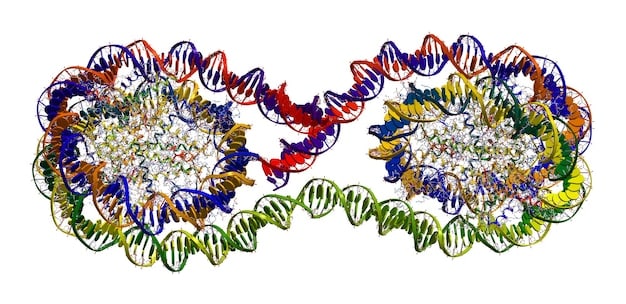US Scientists’ Breakthroughs in Longevity Research

US scientists are at the forefront of pioneering research into the aging process, unearthing profound new insights and developing groundbreaking interventions aimed at extending human longevity and enhancing healthspan.
The quest to understand and potentially reverse the aging process has captivated humanity for centuries. Today, thanks to remarkable advancements in science and technology, we are closer than ever to unlocking the mysteries of longevity. This article delves into New Insights into the Aging Process: What Breakthroughs Are US Scientists Making in Longevity Research?, exploring the cutting-edge discoveries emerging from laboratories across the United States that promise a future where extended health and vitality are within reach.
The Hallmarks of Aging: A Deeper Understanding
Understanding aging begins with dissecting its fundamental characteristics. Scientists have identified “hallmarks of aging”—cellular and molecular changes that drive the aging process. These hallmarks provide a roadmap for researchers, indicating specific targets for therapeutic intervention.
Initially, a seminal paper in 2013 outlined nine such hallmarks. However, ongoing research continually refines and expands this list, offering a more nuanced view of the complex biological pathways involved in aging. This evolving understanding is crucial for developing targeted interventions.
Cellular Senescence: The Zombie Cells
One of the most intensely studied hallmarks is cellular senescence. These “zombie cells” stop dividing but remain metabolically active, secreting inflammatory molecules and damaging surrounding tissue. US scientists are leading the charge in understanding how these cells accumulate with age and contribute to various age-related diseases.
- Senolytics: Drugs that selectively target and eliminate senescent cells. Early clinical trials in the US show promising results in reducing inflammation and improving physical function in conditions like idiopathic pulmonary fibrosis.
- Senomorphics: Compounds that modify the secretome of senescent cells, reducing their harmful effects without necessarily killing them. This approach offers an alternative therapeutic avenue.
- Detecting Senescence: New imaging techniques and biomarkers are being developed to identify senescent cells in living organisms, allowing for precise drug delivery and monitoring of treatment efficacy.
Research into senolytics and senomorphics is rapidly progressing, with several compounds moving through preclinical and clinical development. The potential to clear these deleterious cells could have profound implications for a wide range of age-related conditions, from cardiovascular disease to neurodegeneration.
A key challenge remains ensuring the specificity of these treatments, avoiding harm to healthy cells. US research institutions are meticulously working to refine these therapies, aiming for safe and effective interventions that can one day be widely adopted.
Genomic Instability and Epigenetic Alterations
Aging is not just about wear and tear; it’s deeply intertwined with our genetic material and how it’s expressed. Genomic instability refers to increased damage to DNA and faulty repair mechanisms, leading to mutations. Epigenetic alterations involve changes in gene expression without altering the underlying DNA sequence itself, influencing how our cells read and react to genetic instructions.
US scientists are exploring these areas with particular vigor, recognizing that errors in our genetic programs can profoundly impact cellular function and organismal health. The integrity of our genome is paramount for maintaining cellular health and preventing disease.
DNA Repair Mechanisms
Our bodies possess sophisticated DNA repair systems, but their efficiency declines with age. Researchers are investigating ways to bolster these natural repair processes. Enhancing DNA repair could prevent the accumulation of mutations implicated in cancer and other age-related pathologies.
- NAD+ Augmentation: Nicotinamide adenine dinucleotide (NAD+) is a coenzyme critical for DNA repair. Labs like those at Harvard Medical School are studying how boosting NAD+ levels, often through precursors like NMN or NR, might improve DNA repair and mitigate age-related decline.
- CRISPR-based Therapies: While primarily known for gene editing, CRISPR technology is also being explored for its potential to precisely repair specific DNA damage or correct age-related genetic aberrations.
- Preventive Strategies: Understanding environmental factors that exacerbate genomic instability, such as certain diets or exposures, can inform lifestyle recommendations for promoting genetic health throughout life.
The interplay between genomic instability and epigenetic modifications is complex. Epigenetic changes can affect how accessible DNA is for repair, creating a delicate balance that shifts with age. Decoding this interaction is a major focus for US researchers aiming to intervene effectively.
Recent studies suggest that certain dietary interventions or pharmacological compounds might influence epigenetic marks, potentially reverting cells to a younger state of gene expression. This holds immense promise for treating age-related diseases at their root cause rather than merely managing symptoms.
Metabolic Dysfunction and Nutrient Sensing Pathways
The way our bodies process nutrients and energy fundamentally changes with age. Metabolic dysfunction, characterized by impaired glucose metabolism, insulin resistance, and altered lipid profiles, is a common feature of aging and a precursor to many chronic diseases. US research in this domain focuses on understanding how nutrient sensing pathways regulate longevity and how they can be modulated.
Key among these pathways are mTOR, AMPK, and sirtuins, all of which sense nutrient availability and regulate cellular growth, metabolism, and stress responses. Decades of research have linked the modulation of these pathways to extended lifespan in various model organisms, fueling intense interest in their therapeutic potential for humans.
Targeting mTOR and AMPK
The mammalian target of rapamycin (mTOR) pathway is a central regulator of cell growth and metabolism. Inhibiting mTOR, often through drugs like rapamycin, has shown profound longevity benefits in animal models. Conversely, activating AMP-activated protein kinase (AMPK) promotes energy homeostasis and suppresses anabolic processes, mimicking the effects of caloric restriction.
- Rapamycin and Analogues: Researchers are conducting trials to assess rapamycin’s safety and efficacy in humans for age-related indications, including immune function and cognitive health. Lower doses and intermittent dosing regimens are being explored to mitigate side effects.
- Metformin: A widely used drug for type 2 diabetes, metformin also activates AMPK and has shown potential longevity benefits in observational human studies. The TAME (Targeting Aging with Metformin) trial in the US aims to formally test whether metformin can delay the onset of age-related diseases.
- Dietary Interventions: Caloric restriction and intermittent fasting are known to modulate these pathways, providing a non-pharmacological approach to improving metabolic health and potentially extending healthspan.

Understanding the precise mechanisms by which these metabolic pathways influence aging allows for the development of highly targeted therapies. The goal is to harness their profound effects on cellular health without undesirable side effects.
The work in metabolic research is also deeply intertwined with personalized medicine. Genetic variations can influence how individuals respond to different dietary or pharmacological interventions, suggesting that optimal strategies for metabolic health and longevity may vary from person to person.
Proteostasis Loss and Autophagy
Maintaining cellular health requires a delicate balance of protein synthesis, folding, and degradation—a process known as proteostasis. With age, this balance falters, leading to the accumulation of misfolded or damaged proteins. This “proteostasis loss” contributes to age-related neurodegenerative diseases like Alzheimer’s and Parkinson’s.
Autophagy, a cellular “self-eating” process, is crucial for clearing damaged proteins and organelles. Its efficiency declines with age, exacerbating proteostasis imbalances. US scientists are actively investigating ways to bolster autophagy as a therapeutic strategy against aging and its associated pathologies.
Enhancing Autophagy for Healthspan
Researchers are exploring various compounds and interventions that can boost autophagic flux, thereby promoting cellular cleansing and rejuvenation. This includes both natural compounds and synthetic molecules designed to specifically activate key components of the autophagic machinery.
- Spermidine: Found in fermented foods and whole grains, spermidine has been shown to induce autophagy and improve healthspan in animal models. Clinical trials are underway to evaluate its effects in humans.
- Trehalose: This disaccharide sugar has shown promise in promoting autophagy and clearing aggregated proteins in models of neurodegeneration. Research is exploring its potential for human therapeutic applications.
- Exercise and Fasting: Both physical activity and periods of nutrient deprivation are potent inducers of autophagy, highlighting lifestyle interventions as crucial components of maintaining cellular proteostasis.
The restoration of proteostasis is seen as a critical avenue for combating a wide array of age-related diseases, particularly those affecting the brain. By helping cells efficiently dispose of cellular waste, scientists aim to prevent the buildup of toxic protein aggregates.
Advanced imaging techniques are also being developed to visualize and quantify autophagic activity in living cells and tissues, providing invaluable tools for monitoring the efficacy of new interventions and understanding the dynamics of proteostasis during aging.
Stem Cell Exhaustion and Regenerative Medicine
Our tissues and organs have a remarkable capacity for self-repair, largely thanks to resident stem cell populations. However, with age, these stem cells become “exhausted”—they lose their ability to divide, self-renew, and differentiate into specialized cells. This stem cell exhaustion significantly impairs tissue repair and regeneration, contributing to the overall decline seen in aging.
US scientists are at the forefront of regenerative medicine, exploring ways to rejuvenate or replace exhausted stem cell populations, thereby restoring the body’s intrinsic healing capabilities. This field holds immense promise for treating degenerative diseases and improving quality of life in old age.
Rejuvenating Stem Cell Niches
Stem cells reside in specific microenvironments called niches, which provide crucial signals for their maintenance and function. Research indicates that changes within these niches contribute to stem cell exhaustion. Modulating the niche environment could be a powerful strategy for rejuvenating endogenous stem cell pools.
- Targeting Inflammatory Niches: Chronic low-grade inflammation, often associated with aging, can negatively impact stem cell function. Strategies to reduce inflammation within stem cell niches are being investigated.
- Identifying Rejuvenating Factors: Studies on parabiosis (the surgical joining of two organisms to share blood supply) have revealed that factors in the blood of young animals can rejuvenate tissues in older ones. Identifying these factors opens doors for therapeutic development.
- Cell Reprogramming: Nobel Prize-winning work on induced pluripotent stem cells (iPSCs) has revolutionized the field. Researchers are now exploring partial reprogramming approaches to reset the epigenetic clock of somatic cells, potentially restoring youthful stem cell characteristics without creating tumors.

From growing organs in a dish to developing therapies that boost innate regenerative capacities, the potential applications of stem cell research are vast. The challenge lies in translating these laboratory breakthroughs into safe and effective clinical treatments.
Ethical considerations and regulatory frameworks are also a critical part of this research, ensuring that these powerful technologies are developed and applied responsibly, with patient safety and societal benefit as paramount concerns.
Inflammaging: Chronic Inflammation in Aging
Inflammaging, a portmanteau of “inflammation” and “aging,” describes the chronic, low-grade systemic inflammation that characterizes the aging process. It is distinct from acute inflammation, which is a necessary protective response. Ill-controlled inflammaging is a major contributor to virtually all age-related diseases, including cardiovascular disease, neurodegenerative disorders, metabolic syndrome, and cancer.
US researchers are deeply invested in understanding the origins and consequences of inflammaging, recognizing that mitigating this persistent inflammatory state could significantly extend both lifespan and healthspan. Key drivers of inflammaging include senescent cells, dysbiosis of the gut microbiome, and persistent infections.
Strategies to Combat Inflammaging
Given its pervasive impact, targeting inflammaging is a promising therapeutic avenue. Approaches range from pharmacological interventions to lifestyle modifications, all aimed at dampening the chronic inflammatory signals that wreak havoc on the aging body.
- Senolytic and Senomorphic Drugs: As mentioned, these can reduce the inflammatory secretome of senescent cells, thereby directly addressing a major source of inflammaging.
- Gut Microbiome Modulation: The gut microbiome plays a significant role in modulating systemic inflammation. Researchers are investigating how prebiotics, probiotics, and fecal microbiota transplants can restore a healthy gut balance and reduce inflammaging.
- Specific Anti-Inflammatory Compounds: Beyond broad-spectrum anti-inflammatories, scientists are looking for compounds that target specific inflammatory pathways implicated in aging, offering more precise intervention.
The concept of inflammaging has shifted the paradigm from viewing aging as merely a process of wear and tear to understanding it as a chronic inflammatory condition that requires active management. This perspective opens up new therapeutic possibilities.
Understanding individual differences in inflammatory responses is also important. Genetics, lifestyle, and environmental exposures all contribute to one’s inflammaging profile, suggesting that personalized approaches may be most effective in managing this aspect of aging.
Future Directions and Challenges in Longevity Research
The insights gained into the aging process by US scientists are undeniably remarkable, but the journey towards true longevity medicine is far from complete. The field is rapidly evolving, with new discoveries constantly reshaping our understanding and opening new avenues for intervention. However, significant challenges remain, requiring concerted effort and innovative thinking.
Moving from basic biological insights to clinically applicable therapies is a massive undertaking. It involves rigorous testing, overcoming regulatory hurdles, and ensuring equitable access to these potential life-altering treatments. The goal is not merely to extend life, but to extend “healthspan”—the period of life spent in good health, free from chronic disease and disability.
Translational Science and Clinical Trials
A critical focus for US researchers is the translation of discoveries made in laboratory models into human trials. This involves identifying specific biomarkers of aging, designing robust clinical studies, and developing new methodologies to assess the efficacy of longevity interventions. The complexity of human aging requires sophisticated trial designs that can capture subtle yet meaningful changes in healthspan.
- Biomarkers of Aging: Developing reliable biomarkers (e.g., epigenetic clocks, circulating metabolites) that can accurately measure biological age, distinct from chronological age, is crucial for assessing treatment effectiveness.
- Combination Therapies: Given the multifaceted nature of aging, it’s increasingly clear that a single intervention may not be sufficient. Future approaches likely involve combination therapies targeting multiple hallmarks of aging simultaneously.
- Ethical and Societal Implications: As longevity research progresses, it raises profound ethical, social, and economic questions that require careful consideration and public discourse.
Funding for basic and translational research remains a cornerstone of progress. Public and private investment in aging research is paramount for accelerating discoveries and bringing them to those who can benefit from them.
Collaboration across disciplines—from molecular biology and genetics to clinical medicine and public health—is also essential. The aging process is incredibly complex, and addressing it effectively requires a multidisciplinary approach that harnesses diverse expertise and perspectives.
| Key Area | Breakthrough Focus |
|---|---|
| 🔬 Cellular Senescence | Developing senolytics and senomorphics to eliminate “zombie cells” and reduce inflammation, crucial for reversing tissue damage. |
| 🧬 Genomic Integrity | Researching ways to enhance DNA repair mechanisms and correct epigenetic alterations, maintaining genetic stability. |
| 🍔 Metabolic Pathways | Modulating nutrient sensing pathways (mTOR, AMPK, sirtuins) through drugs like rapamycin and metformin for metabolic health and extended lifespan. |
| 🩹 Regenerative Medicine | Focused on rejuvenating stem cell populations and reversing “inflammaging” to restore tissue repair capabilities and reduce chronic inflammation. |
Frequently Asked Questions About Longevity Research
▼
US scientists are primarily targeting hallmarks such as cellular senescence, genomic instability, epigenetic alterations, loss of proteostasis, mitochondrial dysfunction, altered intercellular communication, and stem cell exhaustion. Research aims to develop interventions that address these fundamental biological processes to extend healthspan.
▼
Yes, several compounds are in various stages of clinical trials. Prominent examples include rapamycin, which targets the mTOR pathway, and metformin, a diabetes drug showing potential longevity benefits. Senolytics, designed to eliminate senescent cells, are also undergoing trials for age-related conditions like idiopathic pulmonary fibrosis.
▼
Genetic research helps identify specific genes and pathways that influence lifespan and disease resistance. By studying long-lived individuals or organisms with extended lifespans, scientists can pinpoint genetic variations that confer longevity, providing crucial targets for developing new therapeutic strategies and understanding the genetic basis of healthy aging.
▼
Healthspan refers to the period of life spent in good health, free from chronic diseases and disabilities. It’s important because the ultimate goal of longevity research is not just to extend lifespan, but to ensure that extended years are accompanied by vitality and a high quality of life, preventing or delaying age-related decline.
▼
Based on current research, key lifestyle recommendations include adopting a balanced diet often mimicking caloric restriction, engaging in regular physical activity, managing stress effectively, and maintaining healthy sleep patterns. These habits positively impact metabolic health, inflammation, and cellular repair processes, contributing to a longer, healthier life.
Conclusion
The remarkable progress made by US scientists in understanding the aging process and developing interventions represents a new era in medicine. From dissecting the intricate hallmarks of cellular aging to pioneering regenerative therapies, these breakthroughs are not merely extending lifespan but are fundamentally reshaping the human healthspan. While challenges remain, the commitment to rigorous research and a multidisciplinary approach promise a future where the burdens of age-related diseases are significantly diminished, allowing for more years of vibrant, healthy living.





